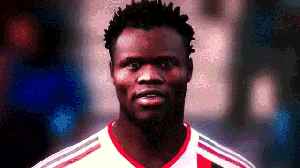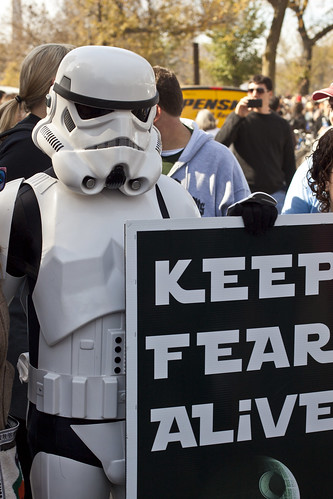Announcement: Magnum Photographer Alec Soth Lectures Wednesday at UT!
Photography fans, take note: esteemed Magnum Photographer Alec Soth will be giving a lecture this Wednesday, October 23 in the Belo Center for New Media. You'll see a selection of Soth's photographic work alongside his commentary about community life in America.
Here's an excerpt from a write-up of his current project, the rest of which you can find here:
At the simplest level, the LBM Dispatch project falls into the long American tradition of expedition and road trip photography. Walking in the footsteps of everyone from Timothy O’Sullivan to Robert Frank, Soth and Zellar have headed out on rambling open ended trips and documented what they’ve found. But unlike their predecessors, Soth and Zellar have brought prose much more fully into the artistic end product; the texts here are not addendums or afterthoughts, but integrated parts of the collaborative storytelling experience. While the James Agee/Walker Evans team is certainly once precedent, I think there is stronger kinship here with the work of Wright Morris, where text and pictures were used with nearly equal brilliance to capture the nuances of specific American places and times.In this particular issue, Soth and Zellar have driven the roads of Colorado, taking in healthy gulps of mountain vistas and frontier spirit. While their trips clearly have a dose of serendipity, these are not really random moments; they’ve done their homework, read their history, and are looking for certain kinds of encounters that will touch on larger themes. This method of building up a narrative is well suited to Soth’s approach to photography; he has never been one to be pigeon holed into just portraits, landscapes, still lifes, or any other type or subject matter, so this kind of vignette-driven storytelling fits well with his natural working style. While rugged snowy mountains and huge storm clouds are an inescapable part of any portrait of Colorado, Soth and Zellar have dug deeper than the stunning landscape, probing the edges of local communities, common folklore, and the undercurrent of violence seemingly inherent to life in this wide open country.Many of Soth’s photographs in this book are portraits of people and objects, seen with an open, unassuming honesty that allows a sliver of the surreal to slip in nearly undetected: a bearded man stands in front of an enormous pile of antlers, while another sports a plastic mask of Doc Holliday, and a woman in formal riding gear waits for her horse perched on a set of stairs, while another beams in her colonial frontier dress amid a row of parked cars. Often, the still life objects and places are secondary evidence, physical remains with some additional resonance: a tombstone of a famous cannibal, the path leading to the Columbine High School memorial, a bullet hole in the wall at Focus on the Family, a rusted out, pock-marked car in the dust near the home of the Dragon Man, a plastic bear torso at a local archery club. Each image tells its own self contained mini-story, and contributes to the weaving of a larger non-linear tapestry of collective impressions.
For more on Soth, see his website here.
For more about American Studies at UT, subscribe to our newsletter here.
Announcement: The Course Transformation Project Continues This Week
The Course Transformation Project in the history department is hosting a series of lunch workshops for faculty and graduate students. This week's theme is: History and its New Pedagogues. This workshop turns its attention to learning history and how we can bring some of the insights from the last session on participatory learning into the unique and demanding discipline in which we are trained and in which we work. The workshop will meet Friday, October 18 in GAR 1.122 at noon. They'll start with Lendol Calder's short article, "Uncoverage: Toward a Signature Pedagogy for the History Survey" (available here). Faculty and graduate students (regardless of your particular field) are encouraged to participate. RSVP to Jessica Luther.
They'll start with Lendol Calder's short article, "Uncoverage: Toward a Signature Pedagogy for the History Survey" (available here). Faculty and graduate students (regardless of your particular field) are encouraged to participate. RSVP to Jessica Luther.
Grad Research: Carrie Andersen writes on videogame glitches and joy in Flow
 Apparently we have quite a bit of publishing going on this month in the American Studies department. Last week, Carrie Andersen published a column for Flow about the joy that arises from discovering absurd videogame glitches, centering on a YouTube personality and gamer named Dopefish. We've posted an excerpt below, and the full article can be found here:
Apparently we have quite a bit of publishing going on this month in the American Studies department. Last week, Carrie Andersen published a column for Flow about the joy that arises from discovering absurd videogame glitches, centering on a YouTube personality and gamer named Dopefish. We've posted an excerpt below, and the full article can be found here:
Unsurprisingly, videogame designers and coders have been concerned with creating virtual, realistic, immersive spaces where the glitch is similarly undesirable (although perhaps not as world-ending). As designer Toby Gard writes, “When we are creating worlds in games, immersion is only possible for the player if we can convince the players that the space is authentic (whether stylized or not.).” The code that underlies the videogame holy grail—the authentic, immersive gaming world—is demystified if a character or background looks warped in such a way that players no longer buy into the illusion.In line with Gard’s concern with the immersive virtual space, media scholar Eugénie Shinkle describes how videogames ideally use sophisticated simulations to hide their intricate, sublime technological codes, but failure events—glitches—make these codes visible and thus rupture bonds between player and game space. Consequently, players can lose control, meaning, and their senses of self. The game shifts from being a virtual arena for exercising player agency and posthuman subjectivity back into a clunky object, as lifeless as any piece of furniture.In all of these cases, glitches occupy a space on a spectrum that spans from the minor irritation to the colossal fuck-up. But constructing the glitch so negatively ignores the real pleasure that can arise from encountering a hiccup in the technological system. What happens when failure events, rather than provoking a loss of our post-human selves or the literal end of the world, instead evoke happiness?
Security/Insecurity in the News, Sept. 27 - Oct. 11
 Hey there, sports fans! Here's your biweekly round-up of security and insecurity in the news:Is ethical parenting possible? (New York Magazine)Marvel’s Diversity Issue: Screen Output Doesn’t Reflect Open-minded Comics (Vulture)Videogames are making us too comfortable with the modern surveillance state (The New Republic)It’s Always Time for a Midlife Crisis: When are people most likely to face a tough stretch? (Slate)'Drones might be the future of food' (The Atlantic)The state of the American war novel (LA Review of Books)Die Like a Man: The Toxic Masculinity of Breaking Bad (Wired)Thomas Pynchon understands the power of conspiracy theories (Salon)Why are there still so few women in science? (The New York Times)How music makes us feel better (The New Yorker)For more about American Studies at UT, subscribe to our newsletter here.
Hey there, sports fans! Here's your biweekly round-up of security and insecurity in the news:Is ethical parenting possible? (New York Magazine)Marvel’s Diversity Issue: Screen Output Doesn’t Reflect Open-minded Comics (Vulture)Videogames are making us too comfortable with the modern surveillance state (The New Republic)It’s Always Time for a Midlife Crisis: When are people most likely to face a tough stretch? (Slate)'Drones might be the future of food' (The Atlantic)The state of the American war novel (LA Review of Books)Die Like a Man: The Toxic Masculinity of Breaking Bad (Wired)Thomas Pynchon understands the power of conspiracy theories (Salon)Why are there still so few women in science? (The New York Times)How music makes us feel better (The New Yorker)For more about American Studies at UT, subscribe to our newsletter here.
